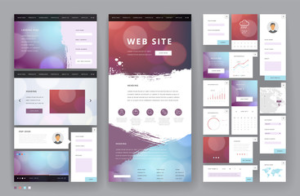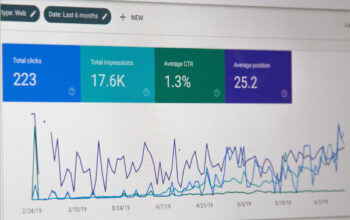A website is a group of interlinked pages under a unique name or web address. Its information is accessible to anyone typing its web address into a browser.
A well-designed site can give a modern impression and increase business credibility. It should also be comfortable to navigate. Visit Website to learn more.

User-friendly web design is a key to driving website conversions. Whether the site is mobile-friendly or responsive, the design should be easy for visitors to navigate and interact with. It also must be designed with the user’s needs and expectations in mind.
This means creating a clear call to action (CTA), which is a button that entices visitors to take the next step on your website, such as submitting a contact form or making a phone call. It also involves clearly explaining the benefits of your product or service.
A user-friendly website is a key to improving customer satisfaction and building brand credibility. In addition, it is a necessary tool for reaching the widest possible audience. In order to create a user-friendly website, consider the following principles:
Less is more: A clean, concise design with a clear value proposition keeps users engaged. This is especially important when you have a large amount of content on your page. A recent study found that most people leave a page within 20 seconds, but pages that offer value can keep visitors around much longer.
Users want control: They want to be able to manage their browser and rely on consistent data presentation. For example, they don’t like having links open in new windows and want to be able to return to the page they were on.
Websites that are user-friendly are based on common concepts and standards that have been discovered over time. These include:
For example, users expect a footer with terms of service and privacy policies and navigation on the top of the page. They also expect websites to load quickly, which is not just good for user experience but also for search engine optimization (SEO). You can improve your website’s load speed by removing unnecessary code and optimizing images.
With the number of internet users growing exponentially, it is no longer enough to design your website for desktop computers. Now, you need to also consider mobile devices like tablet computers and 2-in-1 laptops. This requires a much more dynamic approach to website design, and responsive web design is the key to making it happen.
Responsive website designs use fluid grids to adjust layout elements based on screen size. This allows a website to be more flexible and adapt to different screens without changing the overall look or feel. This also makes it easier to read text and navigate the site on a smaller device. In addition to the benefits of responsive design, it is crucial for search engine optimization (SEO).
A key component of a good website is an effective navigation system. Depending on the screen size, navigational elements may need to be repositioned or removed altogether. For example, a horizontal menu might need to become vertical for the iPhone. The website Etsy is a great example of this. It uses a responsive design and features a prominent search bar that is clearly visible on all devices. This is likely because the company knows that its customers typically browse for a specific product or service rather than navigating the site’s content.
It is important to test responsive designs in real-world conditions. This means testing the website in locations with varying network speeds. This will help you find out how well the site works on different devices and networks. It is also helpful to test your site in a variety of environments, such as inside conference rooms and basements and in known trouble spots for your cell phone’s connection.
Creating a website that is mobile-friendly is essential to attracting and retaining customers. Consumers want a fast, easy shopping experience on websites that are designed for their device of choice, and they’re more likely to make repeat purchases and recommend your business to others if you have an excellent mobile-friendly site.
Mobile-friendly web design includes reducing navigation to a minimal set of links, making images and files smaller for quicker downloads and optimizing text for small screens. It also involves removing unnecessary or redundant information, such as menus, sidebars and social media icons. You should also consider using scrolling features to help users navigate the site and make sure that important information appears at the top of the page when it is viewed on a mobile device.
When designing a mobile-friendly site, it’s important to remember that users are goal-directed, and they’re typically searching for a specific piece of information. Unlike desktop users, mobile users aren’t as likely to click on multiple pages of content or multiple buttons and are more likely to abandon a website if it doesn’t load quickly.
While there are many different approaches to mobile-friendly web design, one that works particularly well is responsive web design. This approach uses a single URL and HTML code for all platforms, and the layout adjusts automatically based on screen size. The site also enables responsive design elements, such as collapsable/ expandable sections and a fixed header for consistent branding across all devices.
A responsive web design will ensure that your website looks good no matter what device a visitor is using, and it can help increase your search engine optimization (SEO) efforts by providing Google with the same view of your site no matter which platform it’s being accessed from. It will also reduce your maintenance costs by allowing you to update your website once and have it appear in all browsers.
Easy navigation is a must for websites because it allows users to quickly access the content they need. It also helps boost user engagement, which can lead to higher conversion rates. When users feel comfortable using your website, they’re more likely to explore other pages and take a call to action, such as making a purchase or filling out a form.
A good way to make your site easy to navigate is by using a logical menu structure and clear labels for each section. This can be done by incorporating a horizontal or vertical navigation bar and organizing sections into categories and sub-categories. This will help prevent confusion and clutter. In addition, it’s important to use a consistent layout for your site’s navigation and links. Avoid using ambiguous or confusing link text and make sure your site is accessible to users with disabilities.
In order to ensure that your website is easy to navigate, it’s a good idea to focus on your business goals and values. This will help you create a design that is unique to your company and will be easier for your website developers to build. It will also save you money and time, as your new website will be more straightforward and require fewer changes.
Website navigation should be easy for all users, including those with disabilities. This will ensure that users can use your site without difficulty and show that your company cares about user experience. Moreover, it will improve your SEO rankings as Google favors sites that are easy to navigate. To do this, you can optimize your website for accessibility by conducting keyword research and analysis, optimizing meta titles and descriptions, ensuring fast loading times, and creating a sitemap.
In order to make your website visually appealing, you must ensure that it is responsive, mobile-friendly, and easy to navigate. You also need to include a good amount of white space and quality images and graphics. You should choose colors that are calming and appealing to the eye and avoid using colors that are too bright or distracting.
Creating a visually appealing website is not just about using nice fonts and images, but rather about designing it for your target audience. You need to understand why your visitors are visiting your site and what their goals are. This will help you design a user-friendly and visually appealing website that is easy to navigate and reflects your brand.
The most important thing to remember is that Web design is not print design, and the two are very different. This is because the Web is dynamic and has a much more fluid and organic feel. It is also difficult to control the way that your design will look for every user. For this reason, it is important to use Web design principles to guide your creation. The most important principles are connection and consistency. These attributes show that your design is professionally designed. They also demonstrate that your design is cohesive and that it is consistent throughout the entire site.
A successful website is not only visually appealing, but it also loads quickly and is easy to navigate. This is especially important in this day and age, when most people expect instant gratification. The faster your site loads, the more likely users will stay on it. To create an appealing website, you should consider incorporating a minimalistic style and clean, simple designs. You should also keep the page content short and simple, and use visual elements sparingly. For example, a call to action such as “learn more” or a small image can catch the user’s eye and draw them in to explore your site further.



